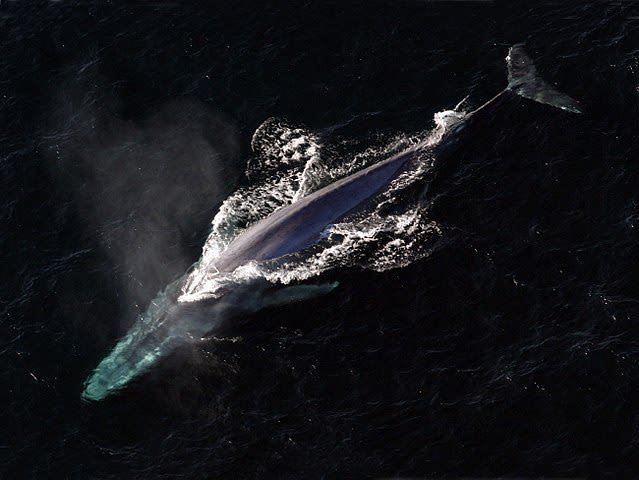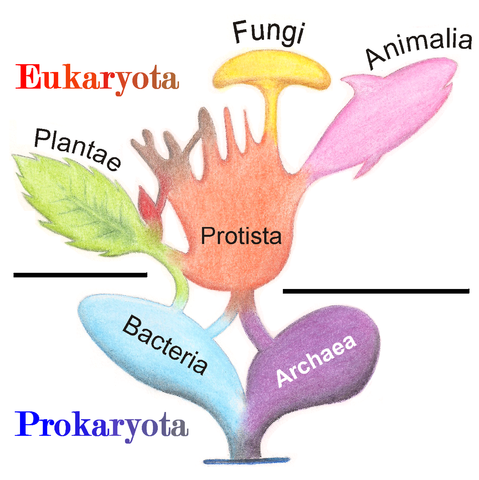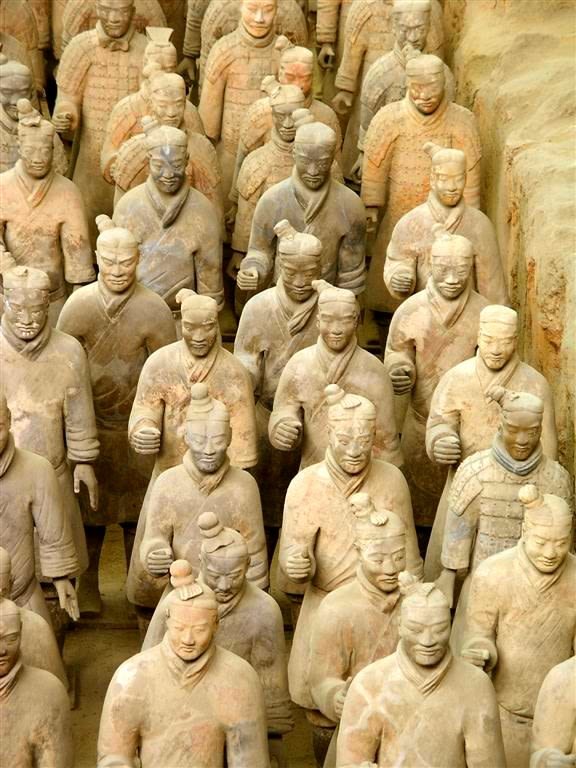How many kingdoms are there?
The answer to this question reveals a lot
about the nature of science. There is no general agreement about how many
kingdoms there are, and opinions keep changing. Many scientists accept the
five-kingdom system described here but just as many do not. In particular,
microbiology experts split the prokaryotes into several different kingdoms.<o:p></o:p>
Kingdom Animalia (animals)<o:p></o:p>
- Includes all the vertebrates (mammals, birds,
reptiles, amphibians, fish) and invertebrates (insects and other arthropods,
molluscs, segmented worms, roundworms, tapeworms/flukes and jellyfish). - Animals are eukaryotic and multicellular.
Their cells have no walls. - They cannot make food, so move in search of
it. They have muscles and nervous systems. The vast majority have a gut.

The blue whale. NOAA Photo Library, Public Domain
Kingdom Plantae (plants)<o:p></o:p>
- Includes flowering plants, conifers and ferns
along with simpler plants such as mosses, liverworts. NB: The algae/seaweeds
are classed as protoctistans, not plants. - Plants are eukaryotic and multicellular.
Cells have walls made from cellulose. There is usually a large vacuole in
mature cells. - Most plants have leaves, stems and roots.
- Most plants possess chlorophyll and make food
by photosynthesis. A few are modified to a parasitic way of life.
Kingdom Fungi<o:p></o:p>
- Includes filamentous fungi and yeasts.
- Single celled fungi are called yeasts.
- Eukaryotic, but the multicellular fungi do
not have separate cells – the nuclei are dotted around in the tissue, - Walls of fungal cells contain chitin.
- Feed by extracellular digestion – secreting enzymes
and absorbing the soluble products. Most feed on dead material, i.e. are
saprophytes. Some are parasitic.
Kingdom Protoctista<o:p></o:p>
The members of this kingdom seem to have very
little in common, more like an assembly of organisms that could not be put into
any other kingdom – a ‘taxonomic dustbin’. The scientific reason for this group
is based on their ancestry and evolutionary relationships.<o:p></o:p>
- Includes single-celled protozoons such as Amoeba
and Plasmodium (the malaria parasite), the algae (including seaweeds)
and sponges. - Their cells are eukaryotic, but show a
diversity of cell types. - They feed in a variety of ways.
Kingdom Prokaryotae<o:p></o:p>
This is the kingdom of bacteria. The cells of
prokaryotic organisms are much smaller than those of eukaryotes. Most feed by
extracellular digestion secreting enzymes and absorbing the soluble products. Most
feed on dead material, i.e. are saprophytes. Some are parasitic. The
cyanobacteria are photosynthetic. Prokaryotes reproduce mainly by binary fission
(splitting in half), but can reproduce sexually. Don’t confuse protoctistans
with prokaryotes. The words look similar but protoctistans are a kingdom of
eukaryotes.
 <o:p>
<o:p>
</o:p>
THE HISTORY OF THE
WORLD<o:p></o:p>
Rocks, and the fossils they contain, can now
be dated by radiometric dating techniques, which measure levels of certain isotopes.
We can use this technique to construct a geological timescale – a biological
history of the world.
 <o:p>
<o:p></o:p>
<o:p>
</o:p>
Dating rocks and fossils<o:p></o:p>
The principle behind radiometric dating is
simple: some elements exist as radioactive isotopes that decay at a predictable
rate. Measurement of this decay allows us to estimate the age of the rock. For
example, when volcanoes erupt, the lava contains radioactive potassium, 40K.
This decays steadily into argon (40Ar). The half-life of 40K
is 1.3 billion (1.3 × 109) years.
So, in 1.3 billion years, half of the potassium decays. Half of the remaining
potassium will decay in the next 1.3 billion years, and so on. By measuring the
ratio of radioactive potassium to argon, scientists can estimate the age of the
rock strata to the nearest 50 000 years.<o:p></o:p>
In many places, layers of volcanic lava
alternate with sedimentary rocks that contain fossils. If we can date the lava,
we can also estimate the age of the fossils. Some fossils of primitive
bacterium-like organisms are thought to be around 3 500 000 000 years old.<o:p></o:p>
Carbon dating<o:p></o:p>
This process can be used to date samples that
still contain some organic material. Cosmic radiation is constantly bombarding
the atmosphere, turning 12CO2 into 14CO2.
This becomes fixed into organic molecules by the process of photosynthesis and
then passes up the food chain. When an organism dies, the 14C decays
into 14N, with a half-life of 5730 years. Carbon dating can be used
to measure the age of any carbon-containing material up to 50 000 years old.<o:p></o:p>
The Earth is currently estimated to be about 4
600 000 000 years old. This time scale is impossible to comprehend, but if we
condense this huge span into one year we can begin to put it into perspective.<o:p></o:p>
SUMMARY<o:p></o:p>
When you have read all this chapter of mine on
evolution series, you should know and understand the following:<o:p></o:p>
Evolution is defined as a change in the
genetic composition of a population over time. New species develop from
pre-existing species in this way. The basic mechanism of evolution is natural selection.
This acts on the genetic variation that occurs in a population. Individuals
whose genotype gives them an advantage over others are more likely to pass
their genes on to the next generation. A population is a group of interbreeding
individuals of the same species in the same geographical area. New species are
formed when populations become isolated in some way so that they cannot
interbreed.<o:p></o:p>
Natural selection then acts on the different populations,
changing the frequency of alleles. With time, the differences between the two
populations can become so great that an individual from one cannot interbreed
with an individual from the other. Humans can speed up the evolutionary process
by artificial selection. Breeding organisms with desirable features, such as
cattle with a high milk yield, changes the allele frequency rapidly.<o:p></o:p>
Within only a few generations, organisms are produced
which are very different from the original wild stock. The evolutionary process
is fastest in species which have a large population size, a large reproductive
capacity (fecundity) and a rapid life cycle. Many disease-causing and pest
organisms fall into this category. Many endangered species have a low
reproductive capacity and a long life cycle.<o:p></o:p>
Evolution happens when there is a change in
the allele frequency. The Hardy-Weinberg principle states that, in a large
population, the allele frequency remains constant unless some outside force
acts to change it. These forces are chance (the smaller the population, the
greater the effects of chance), migration of organisms, selective mating and
natural selection.<o:p></o:p>
When the conditions for the Hardy-Weinberg equilibrium
are not met, the allele frequency changes and the population evolves. All
organisms can be placed into one of the five kingdoms: Animalia (animals),
Plantae (plants), Fungi and Protoctista, which are all eukaryotes, and
Prokaryotae.<o:p></o:p>
This will be the end of my series on
evolution.<o:p></o:p>
Thanks for reading.<o:p></o:p>
REFERENCES<o:p></o:p>
http://www.ric.edu/faculty/ptiskus/six_kingdoms/
https://en.wikipedia.org/wiki/Kingdom_(biology)
https://www.veritasprep.com/the-six-kingdoms-by-veritas-prep/
https://animals.mom.me/list-kingdom-animalia-8031.html
https://byjus.com/biology/animal-kingdom-animalia-subphylum/
https://schoolworkhelper.net/kingdom-animalia-general-characteristics-of-animals/
https://nhpbs.org/wild/animals.asp
https://en.wikipedia.org/wiki/Plant
https://www.toppr.com/guides/biology/biological-classification/kingdom-plantae/
https://untamedscience.com/kingdom/plantae/
https://byjus.com/biology/kingdom-fungi/
https://study.com/academy/lesson/kingdom-fungi-definition-characteristics-examples.html
https://en.wikipedia.org/wiki/Fungus
https://study.com/academy/lesson/kingdom-protista-definition-characteristics-examples.html
https://en.wikipedia.org/wiki/Protist
https://www.thefreedictionary.com/kingdom+Prokaryotae
https://www.encyclopedia.com/science/encyclopedias-almanacs-transcripts-and-maps/prokaryotae
https://www.researchgate.net/publication/288173168_KINGDOM_PROKARYOTAE_Bacteria_Monera_Prokarya
This post has been voted on by the SteemSTEM curation team
and voting trail. It is elligible for support from @curie and @minnowbooster.
If you appreciate the work we are doing, then consider supporting our witness @stem.witness. Additional witness support to the curie witness would be appreciated as well.
For additional information please join us on the SteemSTEM discord and to get to know the rest of the community!
Thanks for having used the steemstem.io app and included @steemstem in the list of beneficiaries of this post. This granted you a stronger support from SteemSTEM.